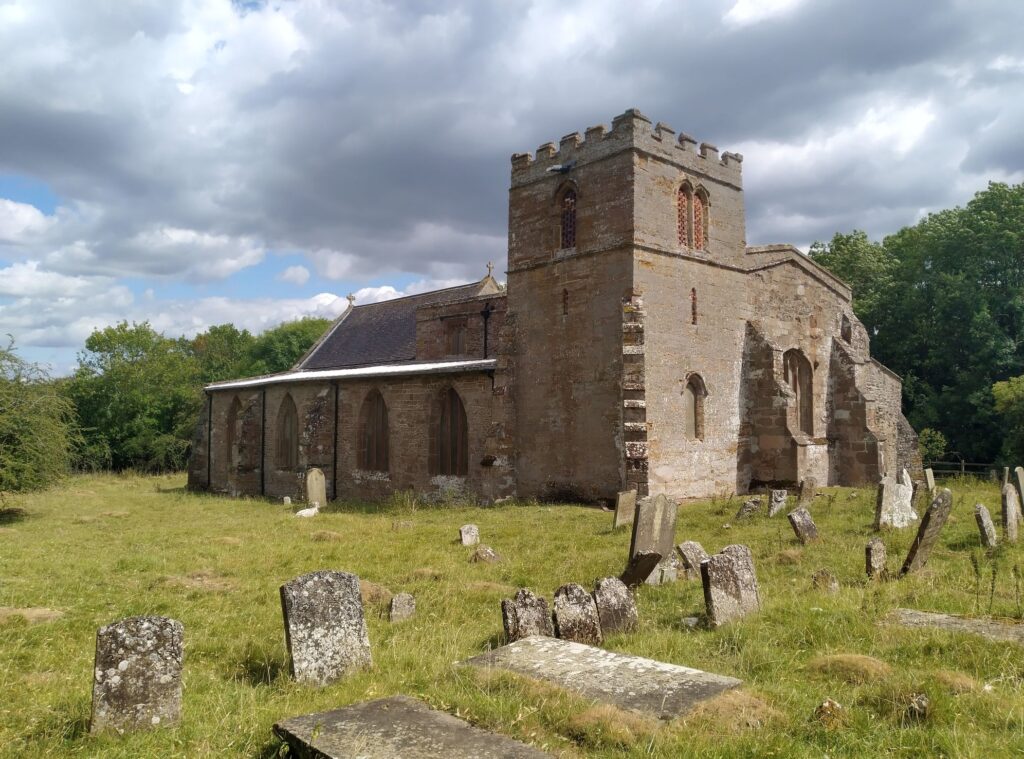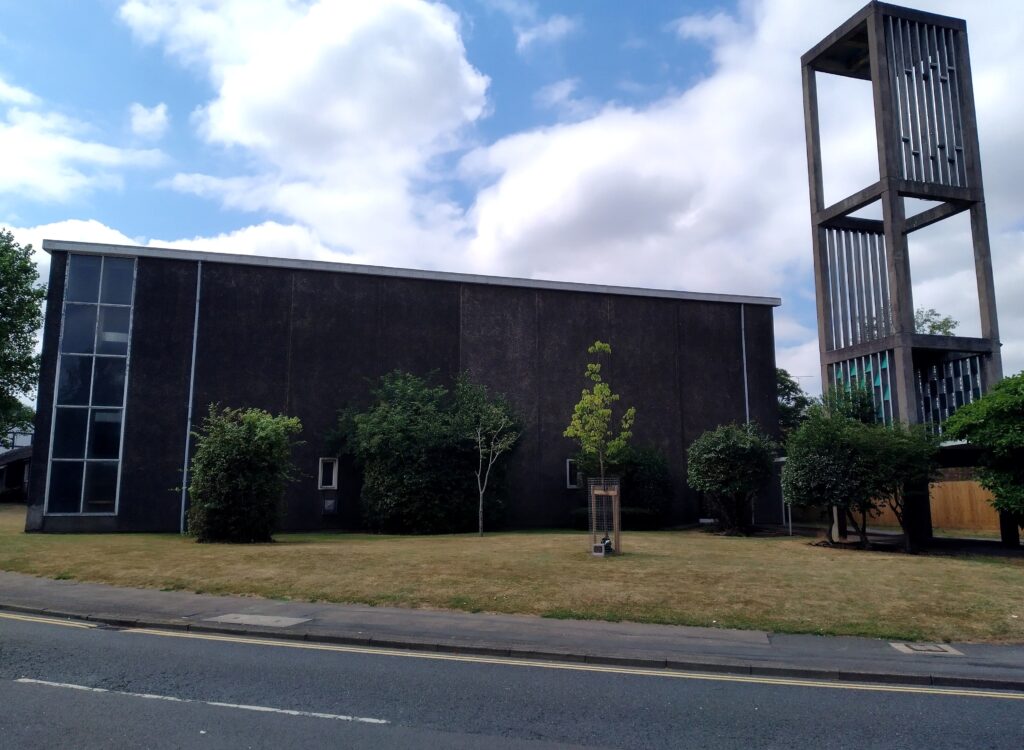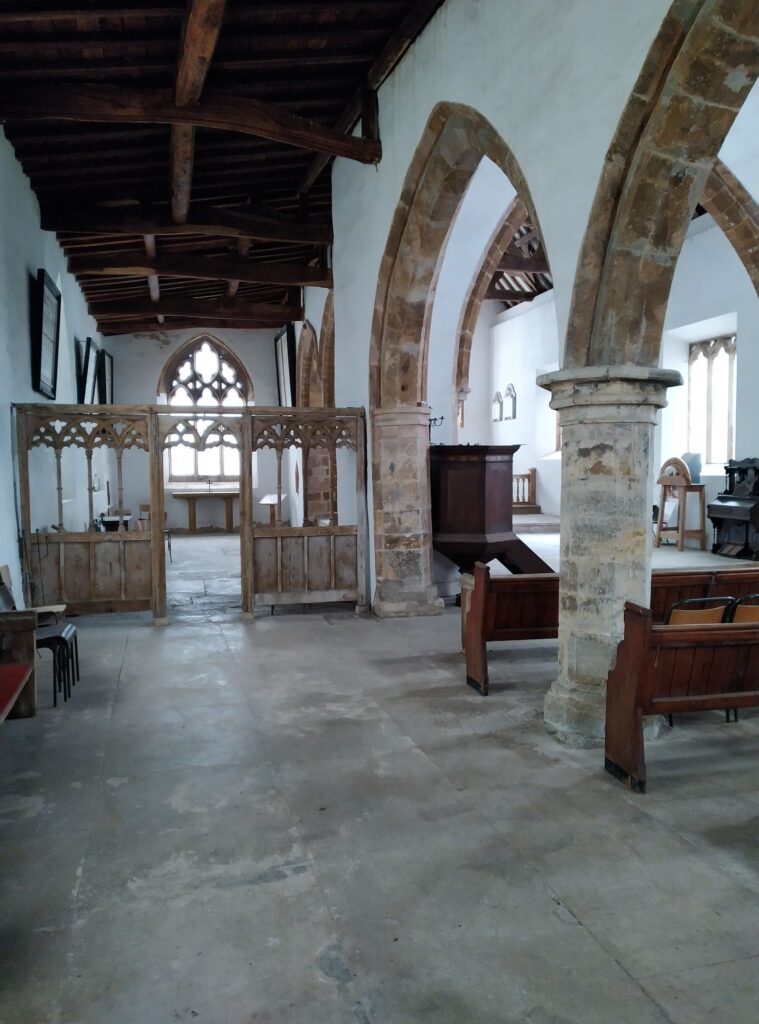With a CovSoc visit to St. John the Divine coming up later this month, Historian and CovSoc committee member, David Porter, tells us an interesting story about a medieval church, that nearly came to Coventry. David writes….
It is sorely tempting to suggest that the motivation behind writing this short piece arises from an extensive study of original diocesan records on my part but I feel obliged to reveal that my initial interest actually stems from an item which an AI-powered algorithm hosted by a well-known search engine decided to send to my mobile phone.
The phone recommendation in question concerned St Peter’s, a medieval church standing at some distance from the small village of Flecknoe beside the Warwickshire/Northamptonshire boundary, not far from Napton. It had originally served the adjoining village of Wolfhamcote, which became depopulated due to the enclosure of its fields for sheep farming in the early 1500s. Nevertheless, in the following centuries services continued to be held there for the benefit of those from other nearby villages until a church was erected in Flecknoe towards the end of the nineteenth century, rendering St Peter’s redundant and ultimately leading to its final closure in the 1950s.

The item went on to reveal that this church was described in an article by John Betjeman published in The Spectator in January 1958, in which the self-styled “church crawler” gave an account of a visit which he and his long-term collaborator John Piper had paid to St Peter’s shortly after the Second World War. Astonishingly, what prompted Betjeman to write his article was a proposal which was then under consideration to dismantle St Peter’s church and relocate it to “a building estate in Coventry.”
Keen to know more, I searched for more information in contemporary newspapers and found an article in the Birmingham Daily Mail from November 1957 which confirmed that such a move was indeed being mooted at the time. To quote from the article, diocesan officials from Coventry were reported as “discussing the possibility of removing [the church] to one of the new urban parishes where churches are badly needed.”
While all of this came as a complete surprise to me, it is well-known that as part of the rebuilding and redevelopment in the city after 1945 Coventry gained a number of new churches, some of which have already been a focus of interest for the Coventry Society as in the case of a talk concerning St Nicholas Church in Radford and a visit to Christ Church in Cheylesmore.
Confining ourselves here for the purpose of brevity to the Church of England, one figure who was central to the growth in the number of such churches at this time was Dr Neville Gorton, who became Bishop of Coventry in 1943. Gorton involved himself in many aspects of the design of new churches in the diocese, apparently insisting upon the replacement of the architect initially appointed to design Christ Church with his own preferred candidate, namely Alfred Herbert Gardner. In similar vein but on a much larger scale, Gorton also became involved in controversy over the design for the new Cathedral, since his insistence on a more modernist style appears to have added to the difficulties faced by Giles Gilbert Scott who had originally been approached to submit a design, ultimately leading to his replacement by Basil Spence.
Given that Gorton remarked of Spence’s new Cathedral design when it was selected in 1951 that it was “the one I should have chosen myself” it is perhaps no surprise that it was Spence whom Gorton appointed as architect when he commissioned three parish churches to be built in the new estates of Tile Hill (St Oswald), Willenhall (St John the Divine) and Wood End (St Chad), all of which were built between 1954 and 1957 to the same generic design so as to minimise costs.

Sadly, Gorton did not live to see these three churches completed as he died on 30th November 1955, but six months prior to this Gorton had been on hand to consecrate another new church in Canley, dedicated to St Stephen. A report published at the time in the Coventry Evening Telegraph article reveals how vitally important he considered these new churches to be, telling the new congregation of his fear that they had “lost contact with the Church when they moved to the Canley district and were now drifting aimlessly.”
In fact just one week before his death, Gorton was still continuing to pursue his ambition to build churches on the new housing estates as shown in the course of a visit he made to Allesley Park, where again he expressed his desire to see a church built to serve the new inhabitants – today, the area is served by Gorton’s memorial church of St Christopher’s, designed by the eminent church architect Nugent Cachemaille-Day and completed in 1960.
Against this backdrop of new churches appearing across Coventry, it will however be noted that the church of St Peter from Wolfhamcote is conspicuous by its absence. By this stage in fact, according to a follow-up article in the Birmingham Mail published in December 1959, the authorities had been considering a new housing estate in Rugby as a possible site for relocation but the personal assistant to the new Bishop of Coventry revealed that St Peter’s would instead be staying in Wolfhamcote after all, explaining that the “cost of moving it would have been at least twice as much as building a new church.”
So the plan to relocate the church was abandoned and yet – in spite of repeated acts of vandalism causing damage both to the external fabric of the building and to the church’s internal features – St Peter’s became the focus of a successful campaign to rescue it from oblivion. Interestingly, in 1970 it was none other than John Betjeman himself who was appointed chairman of the Friends of Wolfhamcote Church and two years later what the poet had styled “this lovely but mysterious building” became the responsibility of The Churches Conservation Trust, which began a programme of remedial works to help save the building.

To turn to the situation today, it is ironic and sobering to note that the post-war church of St Nicholas in Radford mentioned earlier has only recently been demolished because of issues arising with its structural integrity, but in contrast I am happy to report on a more positive note that during a visit to St Peter’s a couple of weeks ago I witnessed repairs being carried out to the windows, allowing some of the temporary plastic sheets to be replaced with traditional glazing for the first time in many years.
Closing if I may on a personal note, my visit to St Peter’s brought to mind Church Going, the poem from the pen of our very own Philip Larkin, in which he concluded when visiting another ancient church that “It pleases me to stand in silence here” – hopefully, others might be prompted to visit St Peter’s, to experience for themselves the silence in what has been described as the church that refuses to die.
Some acknowledgements and notes on sources
The Betjeman article which first aroused my curiosity concerning St Peter’s church is available in full from Page 27 » 3 Jan 1958 » The Spectator Archive.
For those who wish to learn more about St Peter’s past and present, please consult the church website at Wolfhampcote Church – St Peter’s. The Church is typically open between 10:00am and 4:00pm but a key can be obtained from the Old Vicarage nearby by calling 07534 523920.
In preparing this piece, I have made frequent use of Jeremy and Jane Gould’s 2016 book entitled Coventry: The Making of a Modern City 1939-73. In addition, I am indebted to Paul Maddocks for the notes he has produced on the parish churches designed by Basil Spence. More information is available from the database of churches at C20 Churches – The Twentieth Century Society, complemented by the very comprehensive listing at The City of Coventry: Churches, Churches built since 1800 | British History Online. Finally, I am particularly grateful to local architect Matthew Willemsen, who kindly sent me a copy of his excellent unpublished research paper entitled Christ Church and Coventry’s ‘First New Churches’.
From the Coventry Society site, there are pages relating to post-war churches at St. Nicholas Church, Radford – soon to be demolished! – Coventry Society and Christ Church – Coventry Society. The Society will be visiting St. John the Divine Church in Willenhall, on 27th August.
As an addendum, for my own benefit I put together the following table of Anglican churches built in the post-war period in Coventry (in addition of course to the Cathedral Church of St Michael) which I share in case this helps others gain an overview:
| Church | Location | Construction | Architect(s) |
| St John the Divine | Willenhall | 1954-57 | Basil Spence |
| St Oswald | Tile Hill | 1954-57 | Basil Spence |
| St Chad | Wood End | 1954-57 | Basil Spence |
| St Nicholas | Coundon | 1954-57 | Lavendar, Twentyman & Percy |
| St Stephen* | Canley | ??-1954 | Alfred H Gardner |
| Christ Church | Cheylesmore | 1956-58 | Alfred H Gardner |
| St Francis of Assisi | Radford | 1957-59 | N F Cachemaille-Day |
| St Christopher | Allesley Park | 1959-60 | N F Cachemaille-Day |
* A daughter church of St John the Baptist, Westwood, at the time
David Porter
July 2025
